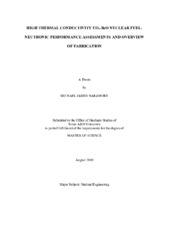| dc.contributor.advisor | McDeavitt, Sean M | |
| dc.contributor.advisor | Ragusa, Jean C | |
| dc.creator | Naramore, Michael J | |
| dc.date.accessioned | 2015-02-05T17:21:40Z | |
| dc.date.available | 2015-02-05T17:21:40Z | |
| dc.date.created | 2010-08 | |
| dc.date.issued | 2010-08-03 | |
| dc.date.submitted | August 2010 | |
| dc.identifier.uri | https://hdl.handle.net/1969.1/ETD-TAMU-2010-08-8434 | |
| dc.identifier.uri | https://hdl.handle.net/1969.1/153193 | |
| dc.description.abstract | The objective of this work was to evaluate a new high conductivity nuclear fuel form.
Uranium dioxide (UO2) is a very effective nuclear fuel, but it’s performance is limited
by its low thermal conductivity. The fuel concept considered here is a ceramic-ceramic
composite structure containing UO2 with up to 10 volume percent beryllium oxide
(BeO). Beryllium oxide has high thermal conductivity, good neutron moderation
properties, neutron production from an (n,2n) reaction, and it is chemically stable with
uranium at high temperatures. The UO2-BeO fuel concept employs a continuous lattice
of BeO within the microstructure of the fuel in order to significantly increase the thermal
conductivity of the fuel.
In order to better understand the effect of this fuel concept on reactor operations 2D
infinite lattice neutronic simulations for a typical pressurized water reactor fuel assembly
were performed using the code DRAGON. Parametric analysis of the beginning of
cycle (BOC) effect of BeO and its corresponding temperature increase revealed that the
introduction of 5 percent by volume BeO into UO2 fuel results in a 400 pcm increase in BOC
reactivity, while the 100 K temperature decrease with the introduction of 10 percent by
volume BeO increased the BOC reactivity by 350 pcm. Cycle length estimates for a
PWR were performed with three and four-batch cycles while keeping the uranium-235
mass constant and the introduction of 10 percent by volume BeO was found to have a 20 day
increase in reactor operation, a 4000-5000 MWd/tHM increase in burnup, and a 2800-
2900 pcm increase in BOC reactivity.
A portion of the work documented here includes the establishment of a UO2-BeO
fabrication method with the necessary equipment. The description of a processing vessel
is provided and the step-by-step procedures for fabrication are described. The
processing vessel has a linear variable differential transducer equipped in order to
characterize the sintering behavior. | en |
| dc.format.mimetype | application/pdf | |
| dc.subject | Beryllium Oxide | en |
| dc.subject | BeO, High Thermal Conductivity | en |
| dc.subject | Neutronic | en |
| dc.title | High Thermal Conductivity UO2-BeO Nulcear Fuel: Neutronic Performance Assessments and Overview of Fabrication | en |
| dc.type | Thesis | en |
| thesis.degree.department | Nuclear Engineering | en |
| thesis.degree.discipline | Nuclear Engineering | en |
| thesis.degree.grantor | Texas A & M University | en |
| thesis.degree.name | Master of Science | en |
| thesis.degree.level | Masters | en |
| dc.contributor.committeeMember | Vierow, Karen | |
| dc.contributor.committeeMember | Radovic, Miladin | |
| dc.type.material | text | en |
| dc.date.updated | 2015-02-05T17:21:40Z | |


